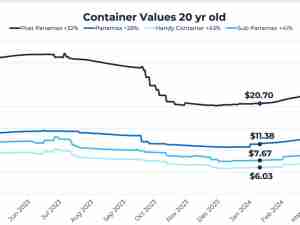2023 has marked a change in fortunes for ocean freight rates from North Europe to the US East Coast, with both spot and long-term contracted prices falling by around 10% since the start of the year.
According to the latest data from Oslo’s Xeneta, long-term rates are now under USD 6 000 per FEU, while spot rates are below USD 6 500 per FEU for the first time since December 2021. Prior to the New Year this trade had withstood market forces with only “soft” rates declines, compared to the dramatic falls seen on other key ocean corridors since last summer.
Peter Sand, Chief Analyst at Xeneta, says the reasons behind the current decline are more complex than many may imagine.
A Victim of its Own Success?
“We are all aware of the macroeconomic forces impacting global consumer demand and international freight volumes,” he states. “That, and the easing congestion at ports, is pushing rates down across the board as carriers suddenly compete for business which, this time last year, was flooding through their doors. However, there’s additional forces at play when it comes to this US East Coast fronthaul.
“In short, it’s a very commercially attractive route right now. When you take freight rates and average transit times into account it offers far greater revenue and thus profitability for the carriers than competing corridors. So, with the increase in blanked sailings from the Far East, and general easing of congestion, carriers have moved available capacity to this trade to take advantage. That, as we can see, is now undermining the high rates that attracted the vessels in the first place.”
Follow the Money
Sand points out that the North Europe to US East Coast trade continued to deliver exceptional profitability for carriers through to the end of last year. At a time when rates were nosediving elsewhere.
He explains: “In Q4 the average transit time here was just over 20 days, delivering an average revenue per TEU per day of USD 360 per FEU for carriers. In contrast, the revenue per TEU per day from the Far East to the US West Coast was only USD 160 per FEU. So, if you have available capacity where would you look to deploy it? It’s a no-brainer: You follow the money.”
Falling from on High
Despite the downward pressure on rates, Sand says the market needs to keep a broader sense of perspective. He notes:
“We shouldn’t lose sight of how historically strong prices are at present. If we look back to January 2021 rates for both spot and long-term agreements for the trans-Atlantic fronthaul averaged around USD 2 000 per FEU, roughly a third of today’s prices. That demonstrates just how high this trade has been flying… but also how much room there is for further falls.”
Interestingly, Xeneta’s data also illustrates that this trade is one of very few where spot prices are still above long-term rates. An important distinction for shippers that, on competing trades, may be tendering for long-term contracts at or around today’s spot rates.
“That’s not a strategy to utilise here,” Sand concludes, “as you’ll most likely end up paying over the odds in the long-term.”








